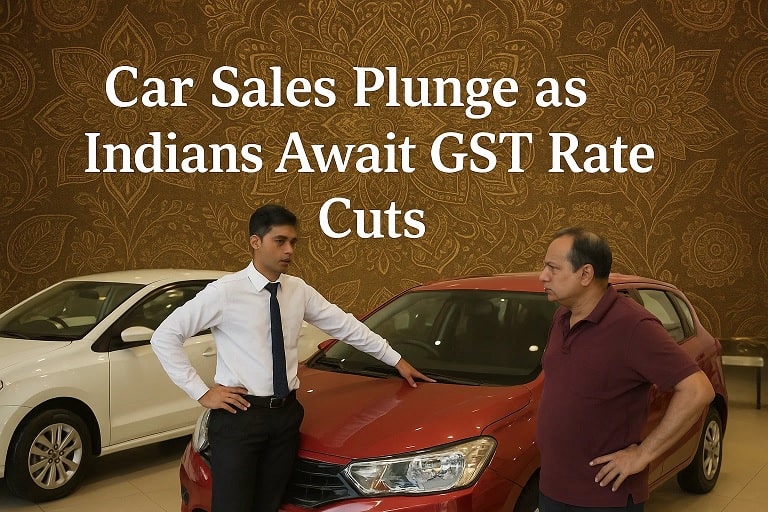Car Sales Plunge as Indians Await GST Rate Cuts: In-Depth Insights for 2025
In India’s bustling automotive market, a notable downturn in car sales has emerged as consumers pause purchases, anticipating reductions in Goods and Services Tax (GST) rates. As of September 1, 2025, major manufacturers are grappling with reduced dispatches, highlighting economic uncertainties. This comprehensive report from CEO Reporter Magazine delves into recent developments, historical patterns, potential reforms, broader implications, and forward-looking scenarios, equipping business leaders with strategic perspectives on the car sales plunge amid GST expectations.
Introduction
The Indian auto industry, vital to national GDP and livelihoods, is encountering a slowdown in 2025. With buyers deferring decisions in hopes of GST cuts that might lower prices significantly, sales have dipped amid inventory build-ups and cautious sentiment. This analysis examines the “car sales plunge in India” linked to “GST rate cuts on vehicles,” offering a detailed overview for stakeholders navigating this shift.
Latest Events Shaping India’s Auto Market
Recent months have witnessed a consistent decline in vehicle sales, influenced by policy rumors and external economic factors. This trend intensifies as the festive period approaches, traditionally a peak sales time.
August 2025 Sales Data: Quantifying the Downturn
August 2025 proved challenging, with leading automakers noting substantial reductions in units dispatched to dealers. Maruti Suzuki reported an 8% drop, Hyundai saw 11% fewer units, and Mahindra & Mahindra experienced a 9% decline. Tata Motors and others followed suit, citing consumer hesitation over potential tax benefits.
For clarity, here’s a table comparing key players’ August 2025 performance against the prior year:
| Automaker | August 2025 Dispatches | August 2024 Dispatches | Year-on-Year Change (%) | Primary Factor |
|---|---|---|---|---|
| Maruti Suzuki | ~350,000 units | ~380,000 units | -8% | Tax cut anticipation |
| Hyundai | ~45,000 units | ~50,500 units | -11% | Delayed consumer buys |
| Mahindra & Mahindra | 75,901 units | ~83,300 units | -9% | Utility vehicle slowdown |
| Tata Motors | ~70,000 units | ~76,000 units | -8% | Overall market caution |
| Industry Total | ~300,000 PV units | ~325,000 PV units | -7.7% | Pre-festive wait-and-watch |
This data underscores the widespread effect, particularly on passenger vehicles.
Key Catalysts: GST Rumors and Broader Influences
Government indications of GST revisions in August 2025 amplified the slowdown, with sales dipping further in the latter half of the month. Retailers anticipate a subdued festive season without prompt resolutions. Additional pressures include international trade policies and domestic employment trends in key sectors.
Historical Evolution of GST in the Auto Sector
To grasp the present scenario, it’s essential to trace GST’s role in shaping India’s automotive landscape over the years.
GST Launch in 2017: Unifying Taxation
Introduced on July 1, 2017, GST consolidated various taxes into a streamlined framework. Vehicles were taxed at 28% base rate, plus cess varying by category, resulting in 29-50% effective rates. This initially stabilized prices, fostering sales growth and positioning India as a global auto powerhouse.
Pre-GST Taxation Hurdles
Prior to GST, multiple levies inflated costs by 10-15%, complicating operations. The reform enhanced efficiency, benefiting manufacturers through better supply chains.
Sales Patterns Over Time: Peaks and Troughs
Post-2017, the sector enjoyed robust expansion until the 2020 pandemic caused sharp contractions. Rebounds followed, with strong growth in subsequent fiscal years. However, 2025 has shown moderation, including early-quarter declines and segment-specific slumps like SUVs.
Effects of Earlier GST Modifications
Adjustments, such as lower rates for electric vehicles, have driven shifts toward sustainable options, while changes in used car taxation influenced secondary markets.
Anticipated GST Reforms: Proposals Under Consideration
Ongoing discussions suggest imminent changes to stimulate demand in the auto industry.
Outline of Suggested Changes for Vehicles
Proposals include reducing GST on compact cars and hybrids from 28% to 18%, potentially cutting prices by 7-10%. Two-wheelers might benefit similarly, with a broader GST structure simplification to fewer slabs, including a higher rate for luxuries. Implementation could occur around major festivals in 2025.
Segment-Wise Advantages
Entry-level models from dominant brands would see the most gains, while premium segments might experience limited relief. Electric vehicles continue at favorable rates to support green initiatives.
Ramifications of the Sales Slump and Prospective Cuts
The current decline carries wide-reaching consequences, yet reforms hold promise for recovery.
Economic Repercussions: On Growth and Employment
The auto sector’s challenges risk affecting millions in jobs and related industries, potentially denting GDP contributions. However, tax reductions could invigorate consumption, supporting broader economic uplift.
Industry-Specific Challenges
Suppliers deal with excess stock, though strong exports provide some balance.
Consumer Perspectives: Benefits and Risks
Lower prices via cuts would enhance affordability, but ongoing delays could lead to missed opportunities during peak buying seasons. Emphasis on hybrids aligns with environmental priorities.
Sustainability Considerations
Reduced taxes on eco-friendly vehicles advance India’s long-term climate objectives.
Future Prospects for India’s Automotive Industry
With potential reforms, the sector could rebound strongly.
Projected Pathways and Opportunities
Post-reform sales might rise 10-15%, driven by affordable segments. Budget allocations emphasize electrification, targeting significant EV adoption by 2030. Challenges like global uncertainties persist, but domestic policies position India favorably.
Strategic Suggestions
Timely policy clarity and integrated incentives are key to sustained growth.
Conclusion
The car sales plunge in India amid awaited GST rate cuts reflects policy-driven market dynamics. While presenting immediate hurdles, these developments pave the way for enhanced accessibility and sector revival. CEO Reporter Magazine continues to monitor this critical narrative for informed decision-making.












